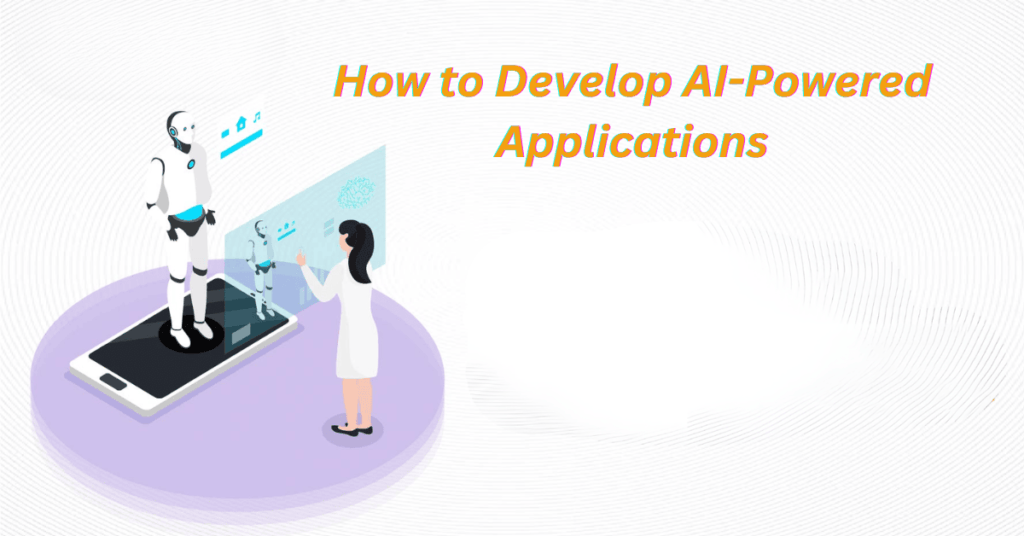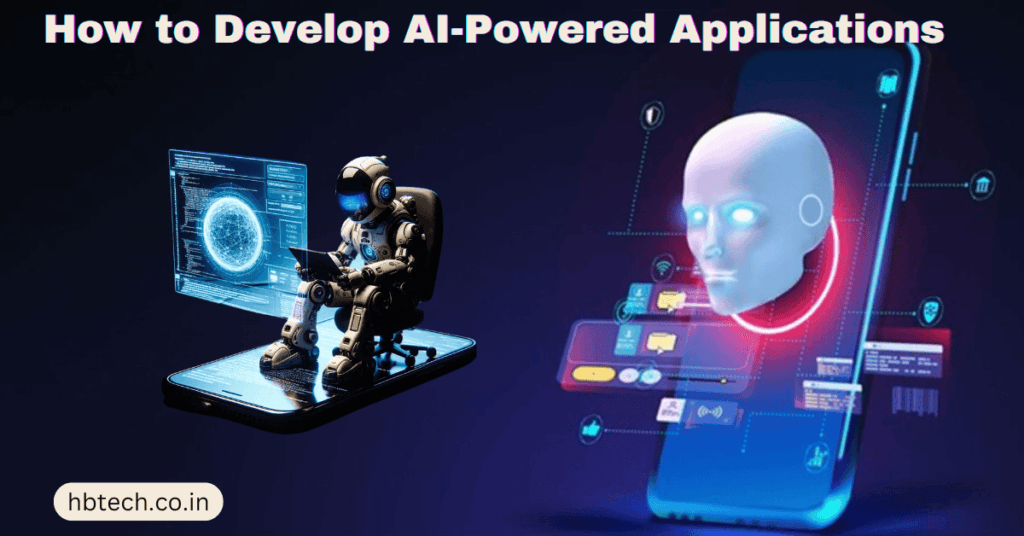Artificial intelligence (AI) is changing the way businesses and industries operate. It helps automate tasks, makes smarter decisions and enhances user experiences. But how do you develop AI-powered applications? Whether you’re an experienced developer or just starting, this guide will walk you through the basics of building AI apps. It will also cover how to use tools like KNIME to create data-driven AI applications.

How to Build AI-Powered Apps: The Basics
Building AI-powered apps can be exciting but also complex. AI apps use machine learning (ML) and other AI techniques to perform tasks like predictions, data analysis or automating processes. Here’s a simple step-by-step breakdown of how to build AI-powered apps :
- Identify the Problem
Start by defining the problem your app will solve. For example, will it help with recognizing images, understanding text or making predictions based on data? - Pick the Right AI Model
Depending on your app’s goal, you’ll need to choose an AI model. For text applications, natural language processing (NLP) models like GPT work well. For image recognition, you’d likely use convolutional neural networks (CNNs). - Prepare the Data
AI models learn from data, so collecting and preparing good-quality data is crucial. Clean and format the data to make sure it’s ready for training. - Train the Model
With your data ready, you’ll need to train your AI model. You can use libraries like TensorFlow or PyTorch to train the model to recognize patterns in your data. - Integrate the Model into Your App
Once your model is trained, it’s time to add it to your app. This might involve using APIs or embedding the model directly into the app itself. - Test and Improve
Test your app thoroughly to make sure it performs well. You might need to adjust your model to improve accuracy or speed. - Launch and Monitor
After everything looks good, launch your AI-powered app. Keep monitoring its performance and make updates as needed to keep it running smoothly.
How to Build AI-Powered Data Apps Using KNIME
KNIME is a great tool for building AI-powered data applications without needing extensive programming knowledge. It’s user-friendly and works well for tasks like data analysis, machine learning and AI development. Here’s how you can build AI-powered data apps using KNIME :
- Install KNIME
First, download and install KNIME on your computer. The platform has a drag-and-drop interface, making it easy to use even if you’re not a coding expert. - Import and Prepare Your Data
Upload your data into KNIME using various data connectors like CSV files or Excel sheets. KNIME also lets you clean and preprocess data with built-in features to transform it for analysis. - Create a Workflow
In KNIME, you build workflows by adding nodes that represent different tasks, such as data importing, transformation and model training. - Train the AI Model
Choose a machine learning algorithm and use KNIME’s tools to train the AI model. KNIME integrates with popular machine learning libraries like Weka and TensorFlow to help you train your model. - Evaluate and Optimize
After training, evaluate how well your model performs using KNIME’s evaluation nodes. You can fine-tune your model to improve its results. - Deploy the App
Once the model is trained and optimized, you can deploy the AI app either locally or to a cloud platform. KNIME makes deployment simple, supporting platforms like AWS and Google Cloud.
Using KNIME, even beginners can develop complex AI-powered data apps without writing much code, making it a great tool for data scientists and developers.
How to Develop AI Applications: Step-by-Step
If you’re starting from scratch and want to dive deeper into AI application development, here’s a more detailed guide :
- Learn the Basics of AI and Machine Learning
Begin by understanding the fundamentals of AI and machine learning. Learn about different types of learning—like supervised, unsupervised and reinforcement learning—and get familiar with common AI algorithms. - Pick the Right Programming Language
Python is the most commonly used language in AI development. It’s easy to learn and has many libraries, such as TensorFlow, Keras and scikit-learn, that make AI development easier. - Understand the Application’s Domain
Whether you’re working on healthcare, finance or another field, understanding the specific needs and challenges of the domain is key to building a successful AI app. - Choose the Right Tools
Depending on your project, pick tools that will help you develop your AI app. For deep learning, TensorFlow and PyTorch are great choices, while scikit-learn is ideal for simpler machine learning models. - Build and Train Your Model
Write code to build your model and then train it using your data. Ensure that you use high-quality, well-labeled data for better results. - Create the User Interface
After training your AI model, you’ll need to build an interface for users to interact with it. This could be a website, mobile app or desktop application, built using tools like Flask, Django or React. - Test, Deploy, and Maintain
Test your AI application thoroughly to ensure it works as expected. Once you’re happy with it, deploy it to production. Be sure to monitor and maintain the app regularly.
How to Make AI Applications: Things to Consider
When creating AI applications, it’s important to keep a few things in mind :
- Data Privacy : Make sure your app complies with data privacy laws, like GDPR or HIPAA, especially if it handles sensitive information.
- Scalability : Your AI app needs to handle large amounts of data. Make sure your app’s architecture can scale to meet future demands.
- User Experience : Even though your app is powered by AI, the user experience should remain simple and intuitive. Focus on making the app easy to use.
How to Start AI Development: Tips for Beginners
If you’re just getting started with AI development, here are some tips:
- Take Online Courses
There are many online courses on platforms like Coursera, edX and Udacity that teach the basics of AI and machine learning. These can help you get started with theory and hands-on practice. - Work on Small Projects
Start with small AI projects, like building a chatbot or a simple image classifier. These will help you learn the basics and gain confidence. - Join AI Communities
Engage with AI communities on platforms like Stack Overflow, Reddit or AI-specific forums. You’ll find support, learn from others and stay updated with the latest trends. - Contribute to Open-Source Projects
Contributing to open-source AI projects on GitHub is a great way to learn from experienced developers and get hands-on experience. - Stay Updated
AI is a fast-evolving field, so make sure you stay up-to-date with the latest developments by reading research papers, blogs and following industry leaders.
Building AI-powered applications can be challenging but rewarding. Whether you’re using KNIME or building everything from scratch, the key steps remain the same: define the problem, gather quality data, choose the right AI model and integrate it into an app. With the right tools, frameworks and dedication, you can create powerful AI applications that make a real impact. So, dive in and start learning—there’s never been a better time to get started with AI!
Frequently Asked Questions(FAQs)
What are the basic steps to build an AI-powered app?
To build an AI-powered app, follow these basic steps :
Define the problem you want the app to solve.
Choose the right AI model that fits your needs, such as machine learning or deep learning models.
Collect and prepare your data to train the model.
Train the model using tools like TensorFlow or PyTorch.
Integrate the trained model into your application.
Test and optimize the app for performance and accuracy.
Deploy the app to production and monitor its performance.How can I use KNIME to build AI-powered data apps?
KNIME is a powerful tool for building AI-powered data applications without extensive coding. Here’s how you can use it:
Install KNIME and set up your environment.
Import and clean your data using KNIME’s built-in connectors and tools.
Create workflows by dragging and connecting nodes that perform tasks like data transformation and model training.
Train the AI model by selecting a machine learning algorithm and evaluating its performance.
Deploy the AI app by integrating it into your workflow or pushing it to cloud platforms like AWS.What are the key things to consider when developing AI applications?
When developing AI applications, consider these factors:
Data privacy: Ensure compliance with data protection laws like GDPR or HIPAA.
Scalability: Design your app’s architecture to handle large amounts of data and scale effectively as your user base grows.
User experience: Make sure the AI-powered features are easy to use and don’t overwhelm the user, even though the app is powered by advanced technology.
Related Posts
- World Wide Technology: A Leader in Technology Solutions
- World of Monster Hunter: Games, Movies, and What’s Next
- Work-Life Balance: Simple Tips for a Happier, Healthier Life
- WhatsApp Banking : How to Check Bank Balance Through WhatsApp
- What’s app Privacy Policy : What’s App got angry || See what What’s App said…
- What Is Convergint Technologies? Everything You Need to Know









